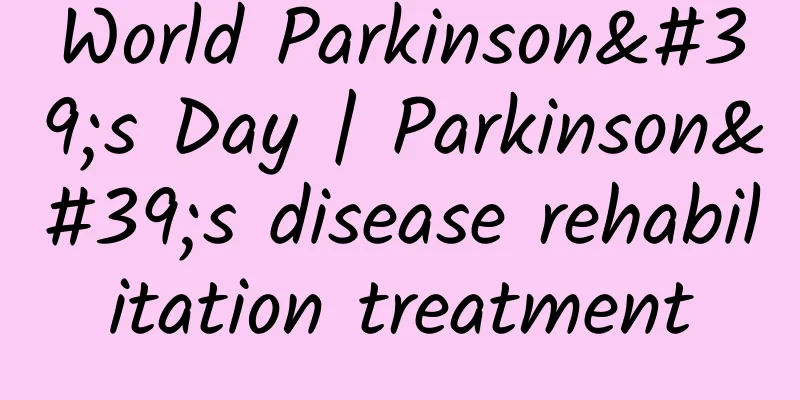World Parkinson's Day | Parkinson's disease rehabilitation treatment

|
Parkinson's disease is a unidirectional disease that cannot be cured, but active and standardized treatment can be used to control symptoms, delay disease progression, and improve quality of life. Therefore, Parkinson's disease should be detected and treated early. There are many kinds of drugs for the treatment of Parkinson's disease clinically. Doctors will choose different drugs at different stages to reduce adverse drug reactions and at the same time delay the progression of the disease as much as possible. Once you have Parkinson's disease, in addition to active drug treatment in medical institutions, we can also carry out active family rehabilitation. The purpose of family rehabilitation is to carry out correct rehabilitation exercises under the professional guidance of rehabilitation therapists, maintain good balance function and muscle and joint mobility, improve the patient's own motor function and endurance to a higher platform and slow down the rate of decline, thereby improving the patient's quality of life and maintaining longer working hours and self-care time. Training method 01 Relaxation and breathing training In a quiet environment, close your eyes and begin breathing deeply and slowly. When you inhale, your abdomen expands and imagine the air reaching the top of your head; when you exhale, your abdomen relaxes and imagine the air flowing down from the top of your head, through your back and to the soles of your feet, relaxing the muscles of your whole body. Repeat this exercise for 5-15 minutes. 02Facial Exercises 1. Frowning action: frown and stretch your eyebrows forcefully, repeat 5 times. 2. Cheek puffing exercise: Puff up and suck your cheeks hard until both sides of your cheeks are sunken. 3. Show teeth and whistle: Show your teeth and make whistling movements. 03Head and Neck Exercises Tilt your head back and look at the ceiling for 5 seconds, moving up and down: lower your head and try to touch your chin to your chest. Turn left and right: Turn your head to the right and look back to the right for 5 seconds, then do the same to the left. Repeatedly and slowly turn your face to the left and right shoulders, and try to touch your shoulders with your chin. Lateral flexion: Slowly move your head toward your left and right shoulders, and try to touch your shoulders with your ears. Forward and backward movement: Hold the jaw forward for 5 seconds, then retract for 5 seconds. 04Torso Exercises **1.** Lateral flexion exercise: Spread your feet shoulder-width apart, bend your knees slightly, stretch your right upper limb upward, palms facing inward, and bend your torso to the left, back and forth 2 times; repeat 2 times on the left side. 2. Rotation exercise: Spread your feet slightly wider than your shoulders, bend your elbows and place your upper limbs flat in front of your chest, and rotate your body to the right and back twice. The movement should be flexible. Repeat in the opposite direction twice. 05Hand Exercises 1. Straighten the metacarpophalangeal joint and flatten the palm. You can use one hand to grab the fingers of the other hand and press toward the back of the hand to prevent metacarpophalangeal joint deformity. 2. Place your palms on the table, try to make your fingers touch the table, and repeatedly practice separating and merging your fingers. 3. Repeatedly practice making fists and extending fingers to prevent deformities of finger joints. 06Gait Exercises 1. When walking, first determine your goal, stabilize your emotions, and concentrate your attention. 2. Look straight ahead, take a step forward, and raise your first step slightly. 3. When walking, touch the ground with your heel first, then your toes, and move your center of gravity to one foot before taking the next step. Swing your arms accordingly. 4. For patients with "frozen gait", draw a horizontal line in front of them and ask them to lift their feet and step over the line. 5. Shout rhythmic commands to the patient while walking, and let the patient move forward step by step to the rhythm of the commands. 07Balance training 1. Stepping exercise: Stand with your legs shoulder-width apart, place your hands naturally at your sides, step on the spot, and swing your hands in coordination. 2. In-situ waist rotation exercise: Stand with your legs apart, shoulder-width apart, and place your hands naturally at your sides. Turn to one side, swing your hands forcefully to that side of your head, and turn to the same side as your hands. Try to keep your pelvis still and maintain balance. 3. Cross-touch exercise: Stand with your legs slightly wider than your shoulders, bend over, touch your right lower limb toes with your left hand, and stretch your right hand upward as far as possible. And vice versa. 08Speech training 1. Move your tongue from side to side between your mouth as quickly as possible. 2. Move the tip of your tongue in a circle around your lips as quickly as possible. 3. Say “La-La-La,” “Ka-Ka-Ka,” and “Ka-La-Ka” as quickly and accurately as possible and repeat several times. 4. Read aloud a newspaper passage or beautiful prose slowly and loudly. |
<<: To stabilize the ankle joint, you need these steps
>>: Who is more likely to get cataracts? These groups of people should pay attention!
Recommend
What should pregnant women do if they always have bloating?
Some pregnant women always have bloating during p...
How to take care of your body after induced labor
Induced labor is actually a normal delivery opera...
Pregnant women with high blood sugar will give birth to a boy or a girl
During pregnancy, there are two situations that c...
4 bad habits that make women unable to keep blood
Anemia often occurs in women. Some women suffer f...
Why does my belly move during pregnancy?
Pregnancy is the greatest thing in a woman's ...
Electrosurgical resection of cervical erosion
Cervical erosion is a disease with a very high in...
Is it safe for women to have breast augmentation surgery?
With the development of science and technology, w...
Consequences and treatment of adnexitis
You may not be very familiar with the series of c...
Can you tell if you have cancer by smell? These "bad smells" in your body may be warning signs of serious illness
Many people think that body odor is a sign of bad...
What are the symptoms of late uterine
The early stage of the disease is not scary, but ...
Symptoms of vaginal cancer
Vaginal cancer is a malignant tumor among gynecol...
How many days after menstruation is ovulation?
Many female friends don’t know when their specifi...
What to do if you have abdominal pain after salpingography
Many women with fallopian tube diseases will unde...
What should I do if my nipples are sensitive during ovulation?
Most women will experience many symptoms during t...









